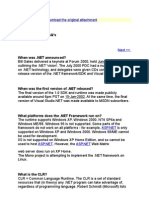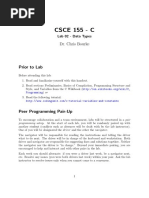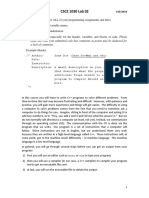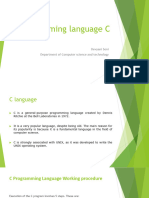Lab Task
Uploaded by
elisiaXXLab Task
Uploaded by
elisiaXXQuestions: 4. Provide the command for generating the map le.
Which of the gcc tools is responsible for producing a map le? 5. What is the content of each of the sections in a map le. Explain briey. 6. Rewrite hello.c to produce entries in the map le for .data, .bss, and .rodata. Hint: This can be done by adding one variable for each type to the le. 7. Add the following function to hello.c: double multiply(double x1, double x2), which returns x1*x2. Use gcc to generate an assembly code listing for the program, and examine the assembly code. What assembly instructions are used to do this? Repeat this task, but now replace double with float. Explain!
The make tool
On Unix systems make is an important build tool. In particular, many programs written in C/C++ depends on make1 to compile, build, and install software. For this part of the lab, run through the example found at http://mrbook.org/tutorials/make/ Questions: 8. How does make know if a le must be recompiled? 9. Provide a make command to use a le named mymakefile instead of the default makefile.
3.1
Using Make: A simple example with library dependencies
In this section of the lab, we are going to develop a small C application that makes use of two libraries. The two libraries are called: lib1 and lib2. The application only knows about lib1, however lib1 will make calls into lib2, as illustrated here: app lib1 lib2 A skeleton of the code is given in the following listings:
void main( int argc, char *argv[] )
{ //Make a table of size give by an argument on the command line. //Fill the table with random numbers between MIN and MAX //MIN = 0.0 if not specified with another value on command line, i.e. optional argument //MAX = 100.0 if not specified with another value on command line, i.e. optional argument //Call tab_sort_sum() in lib1 //Print out table and sum }
double tab_sort_sum( double *tab, int tab_size )
{ //Call tab_sort() in lib2 to get a sorted version back of the table //before calculating the sum of all the elements in the table //Return the sum and the sorted table } For those of you familiar with Java, a popular tool for building large Java projects these days are Maven, which can also help to manage dependencies between libraries used by your project. Another popular tool for Java projects is called Ant, which is very similar to make.
1
Page 3
BOOL tab_sort( double *tab, int tab_size ); { //Sort the table and return true for success }
Task: Write the three C les (main.c, l1.c, l2.c) and prepare the corresponding makele to compile an executable. You must also make corresponding .h les (l1.h, l2.h): Make sure that dependencies are handled correctly. The makele should also contain a TEST target, where all three C les are compiled and tested. You can choose if you want to use specic C les for testing, or if you add test code to the existing les. When executing the TEST target necessary apps and libs must be built and a test executed. A failing test should fail make. Questions: 10. Observe that lib2 makes use of BOOL, but lib1 does not pass this on to main. Rewrite lib1 and main to handle the BOOL. Where and how should BOOL be dened? 11. How do you implement an include guard, and why is it needed?
3.2
Tips
The following should be done to check that your makefile is correct: If you delete a single .o le. Does make rebuild only the necessary les? If you delete a lib le, does the rebuild work as it should? If you change a .h le (e.g. save it to refresh its timestamp), does make rebuild the correct les?
Deliverable for Part 1
A small report where all questions are answered. In assignments where there are several programming steps, only the last need step need to be included. For example, only the last version of the Hello, world! program needs to be delivered.
Part 2, Threads and protections
In this part of the lab, we will look at how threads and protection mechanisms are used in dierent languages and dierent operating system. You will solve the same problem in two dierent languages (see Table 1), one language shall be C, the other is yours to choose. The objective of the assignment is to make a program intended to fail due to lack of protection of a global resource (variable). Then you will implement the program with a protection mechanism and show that the protection is working.
6
6.1
The Program
Global resource:
Create a global unprotected resource. Think simple; for example a variable that more than one thread read-modify-write should suce.
Page 4
6.2
Threads in two languages:
The main() function of your program should create a congurable number of threads (e.g. use command line arguments to congure the number of threads). Each thread should access the global resource a given number of times (could also be congurable through a command line argument). When all of the threads have nished, the number of protection violations should be printed on the console.
6.3
Protection in two languages:
Next, extend your two programs by adding protection on the global resource. When the program completes, the result printed to the console should indicate that no protection violations were discovered. That is, all accesses to the global resource executed appropriately.
6.4
Protection for C language with inline assembly:
Implement low-level protection by using inline assembly with the atomic test-and-set instruction. Before you start on this task, spend some time to gure out: How to add inline assembly2 i C. What an atomic test-and-set instruction is, and why we need it.
6.5
Merge into one application (only for C language )
Combine the C language part of Sections 6.2, 6.3, and 6.4 into on single application where the behavior of the application can be chosen using command line arguments or conditional compilation. Use the method in Listing 2 or Listing 3.
Algorithm
Below we outline the pseudo code for the main program. You may use either the pthread or sthread library for your implementation in C. 1. Create a global resource G 2. Create N threads 3. Start the N threads 4. Wait for all N threads to complete their execution 5. Compare the expected result of G with the actual value, and print out OK/FAIL
Enviroment
Choose two of the languages from Table 1. One of the languages must be C.
8.1
Low-level Protection in C
From the C language we can use standard protection primitives like mutex locks and semaphores. However, we now want you to examine the underlying mechanisms that the operating system uses to ensure that shared data structures are protected from concurrent accesses.
2
This is done dierently in Visual Studio and gcc.
Page 5
Language C C# Java Python Other Questions:
Platform Linux Windows
Table 1: Environment Note Mandatory. Use the gcc compiler Visual Studio Express on own laptop
Windows, Linux or Mac Windows, Linux or Mac Windows, Linux or Mac Only if conrmed with TA
12. What kind of scheduling algorithm is used in your two applications? 13. For C, discuss the pros and cons of using OS locks() vs. inline assembly. 14. Is it also possible to protect your global resource by using the intLock() function, which will disable interrupts? Elaborate.
Deliverable for Part 2
A small report where all question are answered. In assignment where there are several programmingsteps, only the last step should be delivered.
10
Some Relevant Search Keywords
To help point you in right direction for the dierent languages, please take a look at Table 2 for a list of keywords that can give you some ideas or that you can use when searching. Table 2: Keywords Language C Linux Keywords posix, PTHREAD MUTEX INITIALIZER, pthread mutex lock, pthread mutex unlock, pthread create, pthread join InitializeCriticalSection, EnterCriticalSection, LeaveCriticalSection, CreateThread, asm, WaitForMultipleObjects System.Threading, Mutex, WaitOne, ReleaseMutex, ThreadStart The synchronized keyword can be used. But also packages: java.util.concurrent and java.util.concurrent.locks. import threading, global, threading, acquire, release, start, join
C Windows
C# Java Python
Page 6
You might also like
- Computer Systems: Lecture 7: Virtual MemoryNo ratings yetComputer Systems: Lecture 7: Virtual Memory103 pages
- CMSC 216 Project #5 Summer 2021: Assembly Language Programming Due: Tue, Jul 20, 11:55 PM / Fri, Jul 23, 11:55 PMNo ratings yetCMSC 216 Project #5 Summer 2021: Assembly Language Programming Due: Tue, Jul 20, 11:55 PM / Fri, Jul 23, 11:55 PM4 pages
- C# For Beginners: An Introduction to C# Programming with Tutorials and Hands-On ExamplesFrom EverandC# For Beginners: An Introduction to C# Programming with Tutorials and Hands-On Examples5/5 (1)
- All chapter download Guide to UNIX Using Linux 4th Edition Palmer Solutions Manual100% (10)All chapter download Guide to UNIX Using Linux 4th Edition Palmer Solutions Manual44 pages
- All chapter download Guide to UNIX Using Linux 4th Edition Palmer Solutions Manual100% (3)All chapter download Guide to UNIX Using Linux 4th Edition Palmer Solutions Manual34 pages
- Guide to UNIX Using Linux 4th Edition Palmer Solutions Manualinstant download100% (2)Guide to UNIX Using Linux 4th Edition Palmer Solutions Manualinstant download38 pages
- Instant Download for Guide to UNIX Using Linux 4th Edition Palmer Solutions Manual 2024 Full Chapters in PDF100% (11)Instant Download for Guide to UNIX Using Linux 4th Edition Palmer Solutions Manual 2024 Full Chapters in PDF44 pages
- Frequently Asked Questions About CUDA ProgrammingNo ratings yetFrequently Asked Questions About CUDA Programming12 pages
- Get immediate PDF access to the full Guide to UNIX Using Linux 4th Edition Palmer Solutions Manual.100% (5)Get immediate PDF access to the full Guide to UNIX Using Linux 4th Edition Palmer Solutions Manual.38 pages
- Guide to UNIX Using Linux 4th Edition Palmer Solutions Manual - Read Now With The Full Version Of All ChaptersNo ratings yetGuide to UNIX Using Linux 4th Edition Palmer Solutions Manual - Read Now With The Full Version Of All Chapters43 pages
- Guide to UNIX Using Linux 4th Edition Palmer Solutions Manual instant download100% (2)Guide to UNIX Using Linux 4th Edition Palmer Solutions Manual instant download46 pages
- Cs8251 - Programming in C Unit I Basics of C Programming 1. What Are The Different Programming Paradigms?No ratings yetCs8251 - Programming in C Unit I Basics of C Programming 1. What Are The Different Programming Paradigms?34 pages
- Guide to UNIX Using Linux 4th Edition Palmer Solutions Manual pdf download100% (2)Guide to UNIX Using Linux 4th Edition Palmer Solutions Manual pdf download37 pages
- Instructions: Xyz - Training Xyz - Training Xyz - Training.calprintNo ratings yetInstructions: Xyz - Training Xyz - Training Xyz - Training.calprint25 pages
- Object Oriented Programming Using C++: ETCS-258No ratings yetObject Oriented Programming Using C++: ETCS-25827 pages
- Experiment No. 1 Structure of A Program: The Activity AimsNo ratings yetExperiment No. 1 Structure of A Program: The Activity Aims16 pages
- The Activity Aims:: Course Learning Outcomes (Clos)No ratings yetThe Activity Aims:: Course Learning Outcomes (Clos)16 pages
- 6th Sem Basic of .Net Kuvempu UniversityNo ratings yet6th Sem Basic of .Net Kuvempu University11 pages
- Introduction To Codewarrior™ - Simulating The Microcontroller in Assembly LanguageNo ratings yetIntroduction To Codewarrior™ - Simulating The Microcontroller in Assembly Language9 pages
- mcsl-17 C and Assembly Language Programming LabNo ratings yetmcsl-17 C and Assembly Language Programming Lab42 pages
- C Programming Wizardry: From Zero to Hero in 10 Days: Programming Prodigy: From Novice to Virtuoso in 10 DaysFrom EverandC Programming Wizardry: From Zero to Hero in 10 Days: Programming Prodigy: From Novice to Virtuoso in 10 DaysNo ratings yet
- C# Programming Illustrated Guide For Beginners & Intermediates: The Future Is Here! Learning By Doing ApproachFrom EverandC# Programming Illustrated Guide For Beginners & Intermediates: The Future Is Here! Learning By Doing ApproachNo ratings yet
- Writing A Message Broker in Golang: George Vanburgh Supervised by Alvaro A.A. Fernandes May 3, 2016No ratings yetWriting A Message Broker in Golang: George Vanburgh Supervised by Alvaro A.A. Fernandes May 3, 201667 pages
- DBMS UNIT-4 (Database Transactions & Query Processing)No ratings yetDBMS UNIT-4 (Database Transactions & Query Processing)119 pages
- Parallel Computing: Lecture 4: Parallel Software: BasicsNo ratings yetParallel Computing: Lecture 4: Parallel Software: Basics31 pages
- How To Configure PBIS To Join Ubuntu With Windows AD: Download and InstallNo ratings yetHow To Configure PBIS To Join Ubuntu With Windows AD: Download and Install7 pages
- EX200 Red Hat Certified System Administrator (RHCSA) Exam - 2019-09-14No ratings yetEX200 Red Hat Certified System Administrator (RHCSA) Exam - 2019-09-149 pages
- Tutorial Letter 201/2/2018 Solutions To Assignment No.1: School of ComputingNo ratings yetTutorial Letter 201/2/2018 Solutions To Assignment No.1: School of Computing8 pages
- Release of QRadar 7.5.0 Update Package 9 SFS (2021.6.9.20240719124908)No ratings yetRelease of QRadar 7.5.0 Update Package 9 SFS (2021.6.9.20240719124908)12 pages
- Event ID 7011 - Basic Service OperationsNo ratings yetEvent ID 7011 - Basic Service Operations1 page
- Catchlogs - 2023-01-20 at 23-14-18 - 5.12.0.100 (1165) - .JavaNo ratings yetCatchlogs - 2023-01-20 at 23-14-18 - 5.12.0.100 (1165) - .Java22 pages
- Sun Systemss6 Patch Set Installation Note SQLNo ratings yetSun Systemss6 Patch Set Installation Note SQL3 pages
- CMSC 216 Project #5 Summer 2021: Assembly Language Programming Due: Tue, Jul 20, 11:55 PM / Fri, Jul 23, 11:55 PMCMSC 216 Project #5 Summer 2021: Assembly Language Programming Due: Tue, Jul 20, 11:55 PM / Fri, Jul 23, 11:55 PM
- C# For Beginners: An Introduction to C# Programming with Tutorials and Hands-On ExamplesFrom EverandC# For Beginners: An Introduction to C# Programming with Tutorials and Hands-On Examples
- All chapter download Guide to UNIX Using Linux 4th Edition Palmer Solutions ManualAll chapter download Guide to UNIX Using Linux 4th Edition Palmer Solutions Manual
- All chapter download Guide to UNIX Using Linux 4th Edition Palmer Solutions ManualAll chapter download Guide to UNIX Using Linux 4th Edition Palmer Solutions Manual
- Guide to UNIX Using Linux 4th Edition Palmer Solutions Manualinstant downloadGuide to UNIX Using Linux 4th Edition Palmer Solutions Manualinstant download
- Instant Download for Guide to UNIX Using Linux 4th Edition Palmer Solutions Manual 2024 Full Chapters in PDFInstant Download for Guide to UNIX Using Linux 4th Edition Palmer Solutions Manual 2024 Full Chapters in PDF
- Get immediate PDF access to the full Guide to UNIX Using Linux 4th Edition Palmer Solutions Manual.Get immediate PDF access to the full Guide to UNIX Using Linux 4th Edition Palmer Solutions Manual.
- Guide to UNIX Using Linux 4th Edition Palmer Solutions Manual - Read Now With The Full Version Of All ChaptersGuide to UNIX Using Linux 4th Edition Palmer Solutions Manual - Read Now With The Full Version Of All Chapters
- Guide to UNIX Using Linux 4th Edition Palmer Solutions Manual instant downloadGuide to UNIX Using Linux 4th Edition Palmer Solutions Manual instant download
- Cs8251 - Programming in C Unit I Basics of C Programming 1. What Are The Different Programming Paradigms?Cs8251 - Programming in C Unit I Basics of C Programming 1. What Are The Different Programming Paradigms?
- Guide to UNIX Using Linux 4th Edition Palmer Solutions Manual pdf downloadGuide to UNIX Using Linux 4th Edition Palmer Solutions Manual pdf download
- Instructions: Xyz - Training Xyz - Training Xyz - Training.calprintInstructions: Xyz - Training Xyz - Training Xyz - Training.calprint
- Experiment No. 1 Structure of A Program: The Activity AimsExperiment No. 1 Structure of A Program: The Activity Aims
- The Activity Aims:: Course Learning Outcomes (Clos)The Activity Aims:: Course Learning Outcomes (Clos)
- Introduction To Codewarrior™ - Simulating The Microcontroller in Assembly LanguageIntroduction To Codewarrior™ - Simulating The Microcontroller in Assembly Language
- C Programming Wizardry: From Zero to Hero in 10 Days: Programming Prodigy: From Novice to Virtuoso in 10 DaysFrom EverandC Programming Wizardry: From Zero to Hero in 10 Days: Programming Prodigy: From Novice to Virtuoso in 10 Days
- C# Programming Illustrated Guide For Beginners & Intermediates: The Future Is Here! Learning By Doing ApproachFrom EverandC# Programming Illustrated Guide For Beginners & Intermediates: The Future Is Here! Learning By Doing Approach
- Writing A Message Broker in Golang: George Vanburgh Supervised by Alvaro A.A. Fernandes May 3, 2016Writing A Message Broker in Golang: George Vanburgh Supervised by Alvaro A.A. Fernandes May 3, 2016
- DBMS UNIT-4 (Database Transactions & Query Processing)DBMS UNIT-4 (Database Transactions & Query Processing)
- Parallel Computing: Lecture 4: Parallel Software: BasicsParallel Computing: Lecture 4: Parallel Software: Basics
- How To Configure PBIS To Join Ubuntu With Windows AD: Download and InstallHow To Configure PBIS To Join Ubuntu With Windows AD: Download and Install
- EX200 Red Hat Certified System Administrator (RHCSA) Exam - 2019-09-14EX200 Red Hat Certified System Administrator (RHCSA) Exam - 2019-09-14
- Tutorial Letter 201/2/2018 Solutions To Assignment No.1: School of ComputingTutorial Letter 201/2/2018 Solutions To Assignment No.1: School of Computing
- Release of QRadar 7.5.0 Update Package 9 SFS (2021.6.9.20240719124908)Release of QRadar 7.5.0 Update Package 9 SFS (2021.6.9.20240719124908)
- Catchlogs - 2023-01-20 at 23-14-18 - 5.12.0.100 (1165) - .JavaCatchlogs - 2023-01-20 at 23-14-18 - 5.12.0.100 (1165) - .Java

























































































